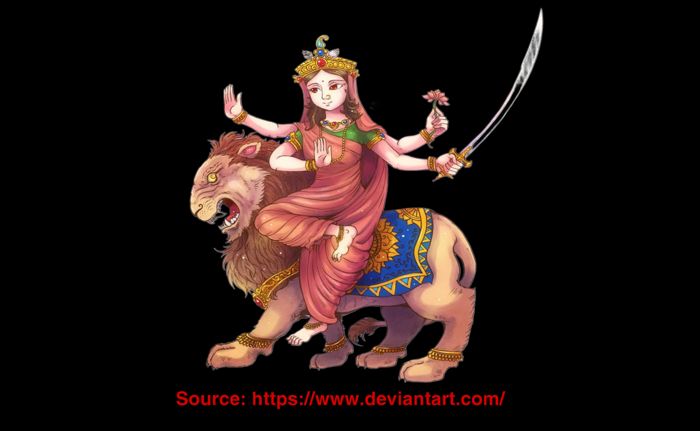The Nine Facets of Devi Durga: Know About Goddess Katyayani
The Fierce Protector: Unveiling the Divine Power of Goddess Katyayani on the Sixth Day of Navratri
On the sixth day of Navratri, devotees across India and the world worship Goddess Katyayani, a powerful form of Devi Durga. Known for her fierce strength, she embodies courage, righteousness, and the ability to eliminate evil. Goddess Katyayani is revered as the slayer of the demon Mahishasura, a symbol of the triumph of good over evil.
Katyayani is unique among the forms of Durga, as she was born from the collective anger of the Tridev – Brahma, Vishnu, and Shiva – to destroy the demon who could not be killed by any man or god. She was later named Katyayani after Rishi Katyayan, a sage who performed severe penance and was blessed with the honor of having the goddess manifest in his household. Worshiping her brings blessings of strength, courage, and the ability to overcome obstacles, both external and internal.
Mythological Significance of Goddess Katyayani
The story of Goddess Katyayani is deeply embedded in Hindu mythology, specifically in relation to her role in the defeat of Mahishasura. Mahishasura, a powerful demon, had received a boon that no man or deity could defeat him. Empowered by this, he unleashed terror across the three worlds – heaven, earth, and the underworld – creating chaos and destruction wherever he went.
Unable to control the demon’s rampage, the gods, led by Brahma, Vishnu, and Shiva, combined their divine energies to create a powerful warrior goddess. Their collective wrath gave birth to Katyayani, a form of Durga. Her creation was infused with the strength and powers of all the gods, making her the ultimate embodiment of divine feminine power capable of destroying Mahishasura.
Once born, Katyayani descended to earth to fight Mahishasura. The fierce battle between the goddess and the demon lasted several days. Her victory is a reminder of the supreme power of the divine feminine and the inevitable triumph of good over evil.
The Role of Rishi Katyayan in Naming the Goddess
While the divine origin of Katyayani stems from the anger of the Tridev, she was named after Rishi Katyayan, a sage who had longed to have the goddess born in his household. Rishi Katyayan was a great devotee of Devi and performed intense penance to seek her blessings. Pleased by his devotion, the goddess granted him a boon, promising that she would be born as his daughter when the need for her manifestation arose.
When the time came for the destruction of Mahishasura, Goddess Durga manifested in Rishi Katyayan’s hermitage, taking the form of Katyayani, and she eventually went on to slay the demon. This is why she came to be known as Katyayani, the daughter of Rishi Katyayan.
Symbolism of Goddess Katyayani
Goddess Katyayani is portrayed as a fierce and powerful form of Durga, often depicted with four arms and riding a lion. She holds a sword, a lotus, and other hands in Abhaya mudra. Her lion signifies bravery, and her posture exudes a sense of righteous aggression, necessary for the destruction of evil. The lotus in her hand represents purity and spiritual awakening. Despite her fierce appearance, the lotus reminds devotees that Katyayani’s ultimate purpose is to restore balance and purity in the world.
Support Independent Journalism? Keep us live.
Katyayani is also connected with the Ajna Chakra, or the third-eye chakra, which governs wisdom, intuition, and spiritual insight. Worshiping her is believed to help open this chakra, allowing devotees to achieve greater clarity, insight, and inner vision.
Spiritual Importance of Worshiping Goddess Katyayani
Worshiping Goddess Katyayani on the sixth day of Navratri holds immense spiritual significance. Known as the protector of righteousness and destroyer of evil, she is invoked to seek strength, courage, and protection from negative influences. Her fierce energy helps devotees overcome internal struggles like fear, doubt, and insecurity, as well as external challenges in life.
Katyayani is particularly revered by young women, as she is believed to bless them with a suitable life partner. In various regions, young unmarried girls perform special Katyayani Puja to seek the goddess’s blessings for a happy and harmonious marriage. This practice is mentioned in the ancient Hindu scriptures, where Gopis of Gokul are said to have worshiped Katyayani to be united with Lord Krishna.
Katyayani is also a symbol of feminine strength, representing the power to protect and nurture while also having the fierceness to fight against injustice. Her blessings are sought by both men and women who wish to invoke courage, wisdom, and mental strength to confront their life’s adversities.
Rituals and Offerings to Goddess Katyayani
The rituals associated with worshiping Goddess Katyayani on the sixth day of Navratri begin early in the morning. Devotees take a bath, wear fresh clothes, and offer prayers to the goddess, seeking her blessings. The color associated with the sixth day of Navratri is yellow, which represents joy, positivity, and energy.
Offerings made to Katyayani include yellow flowers, particularly marigolds, sweets like honey and jaggery, and various fruits. Honey, a favorite offering of the goddess, is symbolic of devotion and sweetness in life. Devotees light lamps, incense, and chant mantras dedicated to Katyayani, such as the Katyayani Mantra, to invoke her divine energy.
On the sixth day of Navratri, Goddess Katyayani is worshiped as the fierce protector of the universe and the destroyer of evil. Born from the anger of the Tridev and named after Rishi Katyayan, she represents divine strength, righteousness, and the ultimate victory of good over evil. By worshiping Katyayani, devotees seek her blessings for courage, protection, wisdom, and the ability to overcome life’s obstacles.
Her fierce yet nurturing energy reminds us that divine strength can be both protective and destructive when necessary, and her blessings bring strength, peace, and prosperity to those who seek her guidance.


Comments are closed.